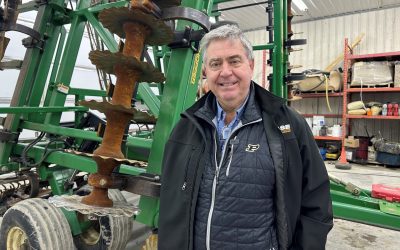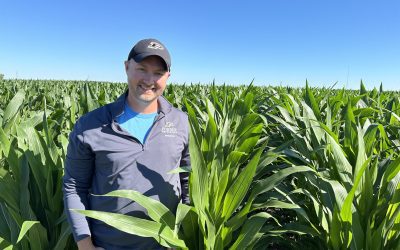New program focuses on outcomes of soil and water conservation practices
Posted: November 3, 2022
Category:
ICMC, Indiana Corn and Soybean Post - Fall 2022, ISA
The enrollment period is now open for farmers interested in participating in the Soil and Water Outcomes Fund. Rather than provide farmers payment for practice implementation, the Soil and Water Outcomes Fund provides payment to farmers for the multiple environmental outcomes of new conservation practices implemented on their farms. These outcomes include water quality improvements and carbon sequestration.
“The unique aspect of this program is that it focuses on the outcomes of the soil and water conservation practices,” said ISA board member Anngie Steinbarger, a farmer from Edinburgh, Ind. “This is another opportunity for farmers to receive a payment for taking care of their own land. I encourage farmers to
The eligible region for enrollment includes 49 counties in central and southern Indiana. Farmers in the following Indiana counties are eligible to enroll: Bartholomew, Brown, Clark, Clay, Crawford, Daviess, Dearborn, Decatur, Dubois, Fayette, Floyd, Franklin, Gibson, Greene, Hamilton, Hancock, Harrison, Hendricks, Henry, Jackson, Jefferson, Jennings, Johnson, Knox, Lawrence, Madison, Marion, Martin, Monroe, Morgan, Ohio, Orange, Owen, Perry, Pike, Posey, Putnam, Ripley, Rush, Scott, Shelby, Spencer, Sullivan, Switzerland, Union, Vanderburgh, Warrick, Washington and Wayne.
What is this Fund?
The Soil and Water Outcomes Fund is a partnership of AgOutcomes, a subsidiary of the Iowa Soybean Association, and ReHarvest Partners, a subsidiary of Quantified Ventures. The Fund advises farmers to tell them what practices they would like to implement; then, the Fund will estimate the environmental outcomes. Once the outcomes are verified, farmers will receive a payment from the Soil and Water Outcomes Fund.
These environmental outcomes are then sold by the Soil and Water Outcomes Fund to beneficiaries including corporations seeking to offset greenhouse gas emissions in their supply chain. Other buyers could include public entities such as municipal water utilities or state and federal departments of agriculture seeking to improve and safeguard water quality.
While the Fund is not prescriptive about the conservation practices that farmers can implement, those who participate typically implement the following practices:
- No-till or reduced tillage
- Cover crops
- Extended crop rotations
These practices enhance financial resiliency on a farming operation through diversified revenue streams and promote ecological resilience through improvements in soil health.
“Farms are disappearing right before our eyes. Something’s got to change,” said Lance Lillibridge, an Iowa farmer and a Soil and Water Outcomes Fund participant. “My field- that’s my retirement. That’s my 401(k). I’m taking the best care of it that I can, because someday I’ll need it to take care of me.”
Farmers and landowners in counties across 10 states are now eligible to enroll acres in the Soil and Water Outcomes Fund. In addition to Indiana, these states include Delaware, Illinois, Iowa, Maryland, Missouri, New York, Pennsylvania, Virginia and West Virginia.
An opportunity for Hoosier farmers
ISA Sustainability and Value Creation Director Ben Forsythe said, the more practices a farmer includes, the higher outcome payment they can generate. Soil types and baseline practices affect the outcomes, so it is hard to consistently say what each practice yields for an outcome payment. At minimum, farmers will most likely need to use cover crops and either reduced or no tillage.
The contract is currently one year at a time. Farmers can re-enroll acres if they are willing to continue and include more practices. Farmers will receive half of the payment in the spring to help with seed costs, etc. and the balance is paid during the winter after outcomes and practices are verified. There is not an acre cap per farmer.

Farmers who are currently no-tilling and using cover crops will still need to add at least one additional conservation practice. Forsythe suggested farmers break down their operation field-by-field and decide if there is a practice that can be added.
“Is 100 percent of your operation using no-till and cover crops?” Forsythe asked. “If not, the Soil and Water Outcomes Fund should be a fit for the rest of your fields.”

Hoosier farmers who are only seeding a cover crop ahead of soybeans could also add it in front of corn.. Adding diversity to a corn and soybean rotation. would also be considered an eligible change.
For additional information regarding the Soil and Water Outcomes Fund or to enroll, visit www.theoutcomesfund. com/enroll or contact SWOF Conservation Agronomist Kevin Schabacker at 779-861-2979. Farmers may also contact Forsythe at bforsythe@indianasoybean.com.



